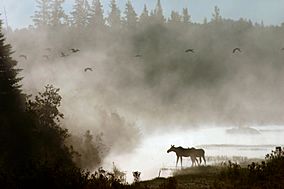Aroostook National Wildlife Refuge facts for kids
Quick facts for kids Aroostook National Wildlife Refuge |
|
|---|---|
|
IUCN Category IV (Habitat/Species Management Area)
|
|

Moose at Aroostook National Wildlife Refuge, August 2005
|
|
| Location | Aroostook County, Maine, United States |
| Nearest city | Limestone |
| Area | 5,252 acres (21.25 km2) |
| Established | 1998 |
| Governing body | U.S. Fish and Wildlife Service |
| Website | Aroostook National Wildlife Refuge |
Aroostook National Wildlife Refuge is a special place in Aroostook County, Maine, United States. It was created in 1998 to protect important wildlife. This refuge used to be part of a military base called Loring Air Force Base. Now, it's a safe home for many animals and plants. The refuge is managed by the United States Fish and Wildlife Service. It helps keep nature safe in an area mostly used for farming, like growing potatoes and broccoli.
Contents
Discover Aroostook National Wildlife Refuge
The Aroostook National Wildlife Refuge covers about 5,252 acres (21.25 km2) of land. This makes it a large natural area within the town of Limestone. The refuge was created when 4,700 acres (19 km2) were transferred from the United States Air Force to the United States Fish and Wildlife Service.
Besides its main area, the refuge also helps protect about 2,400 acres (970 ha) of wetlands across Aroostook County. These wetlands are important natural areas that help keep the environment healthy. The refuge is also close to Aroostook State Park, where people can go hiking during certain times of the year.
A Home for Amazing Animals
The Aroostook National Wildlife Refuge is a great place to see many different kinds of animals. The refuge has various types of habitats, which means it can support a wide range of wildlife.
Birds You Might See
Many birds use the refuge's wetlands. You might spot black ducks, wood ducks, and hooded mergansers. During spring and fall, Canada geese can be seen on East Loring Lake and the Little Madawaska River.
The large forested areas of the refuge are perfect for migratory songbirds to build their nests. In spring and summer, you can hear and see many warblers. These include the black-throated green, Canada, bay-breasted, Cape May, and Blackburnian warblers. These "neotropical migrants" spend their summers here and then fly south for the winter. They travel to places like Mexico, the Caribbean, and Central and South America.
The refuge also has grasslands that are home to birds like upland sandpipers, bobolinks, and Savannah sparrows. Woodcocks use the grassy spots for their courtship dances and the forested areas for nesting.
Mammals and Other Animals
You can often see many animals feeding in the farm fields next to the refuge. They also look for food along stream banks and in forested wetlands.
Some of the common mammals you might spot include river otters, minks, and red foxes. Other animals that live here are bobcats, coyotes, fishers, and even lynxes. Smaller animals like muskrats, gray foxes, beavers, raccoons, and snowshoe hares also call the refuge home.
Larger mammals like black bears and moose are also residents of this refuge. Keep an eye out for them, especially in the forested areas!


